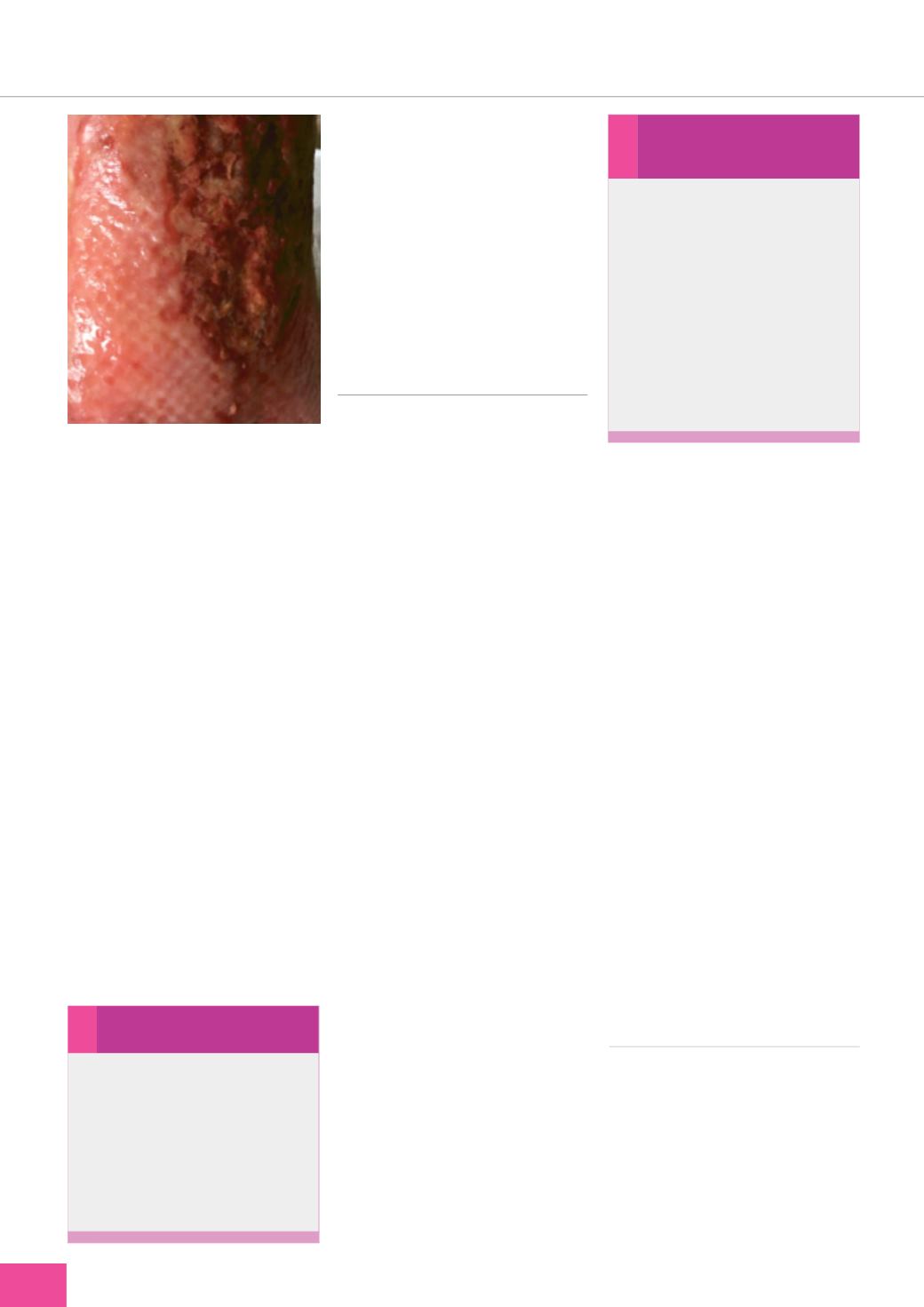
34
WOUND CARE TODAY
2017,Vol 4, No 1
FOCUS ON
M
OISTURE
›
The volume of exudate produced
should be recorded at each review,
and although quantifying its
volume is subjective, it should
be documented accurately and
consistently to make it meaningful
to all clinicians who access the
patient’s notes.
Exudate colour
The colour of exudate can identify
if the wound is progressing or
deteriorating.
Table 1
highlights
the different colours of exudate
encountered in practice and what
they reveal about the patient and
their wound.
Exudate consistency
The consistency of exudate can
also help to provide clues as to
the presence of factors that might
delay healing. For example, a thick,
purulent exudate may indicate
infection, while thin, watery exudate
may be a sign of underlying venous
or cardiac disease (WUWHS, 2007).
Odour
Healthy exudate is clear, straw-
coloured and odourless. If malodour
is present, this could be because of:
›
Infection
›
The presence of necrotic tissue
›
An enteric or urinary fistula
(WUWHS, 2007).
Like exudate volume, the
assessment of odour is subjective, so
should be recorded according to
local protocol.
LOCAL WOUND MANAGEMENT
To obtain moisture balance, the
condition of the wound bed
should be optimised, along with
the medical management of
any comorbidities that may be
contributing to exudate production.
Unfortunately for some patients,
e.g. those with a malignant wound
or arterial leg ulcer, there may be
no treatment for the underlying
cause of the wound so exudate
management should focus on
skin protection and the relief
of symptoms such as pain and
malodour (Vowden et al, 2015).
In clinical practice, exudate
balance is mainly achieved by
the judicious use of wound care
dressings and the regularity with
which they are changed in relation
to the volume of exudate being
produced to maintain a moist
wound healing environment (Cook
and Barker, 2012; Dowsett, 2012).
When a wound is producing
a moderate to high volume of
exudate, a wound dressing is
needed that can absorb a
large volume of fluid. In some
circumstances, the dressing
will need to retain fluid under
pressure, such as when worn under
compression or on a weight-bearing
part of the body (Tickle, 2016).
If the wound requires frequent
dressing changes to manage the
exudate produced, a superabsorbent
dressing may be needed.
Superabsorbent dressings are
designed to absorb a large volume
of wound exudate and retain it
within the dressing structure,
thereby protecting the wound and
surrounding skin from damage
(WUWHS, 2007). This also helps to
reduce dressing change frequency,
which again not only protects the
periwound skin by reducing the risk
of skin stripping (Drewery, 2015),
but also provides a cost-effective
option as a result of reduced
nursing time — an important
consideration in today’s health care.
In addition to its ability to
absorb and retain exudate, the ideal
dressing should also:
›
Be comfortable to wear, without
interfering with activities of
daily living
›
Be easy to apply and remove
›
Reduce pain
›
Reduce odour
›
Be clinically and cost-effective
›
Be available in a variety of sizes
(WUWHS, 2007).
Patient preference should always
be considered when choosing
dressings, so that they can feel
partners in their own care.
REASSESSMENT
It is important to continually
reassess the wound, because as
it heals, the characteristics of
exudate will change (Dowsett,
2008). Accurate assessment and
interpretation of wound progress
(
Table 1
) are therefore crucial to
the development of appropriate
management strategies (Ousey and
Cook, 2012).
›
What is excoriation?
Excoriation describes damage
caused to the skin by the
proteolytic enzymes present in
chronic wound fluid (Wolcott et
al, 2008).
It presents as red, inflamed
skin (erythema), with a loss
of skin integrity.
›
What is
maceration?
Periwound maceration, which
presents as white, soggy skin
within 4cm of the wound edge
(Dowsett and Allen, 2013) is
caused by over hydration of
the epidermis.
It occurs when dressings are left
in situ
for too long, or if they are
unable to handle the volume of
exudate being produced, resulting
in prolonged contact of moisture
with the skin.
Figure 1.
Uncontrolled wound exudate
causes periwound maceration.








